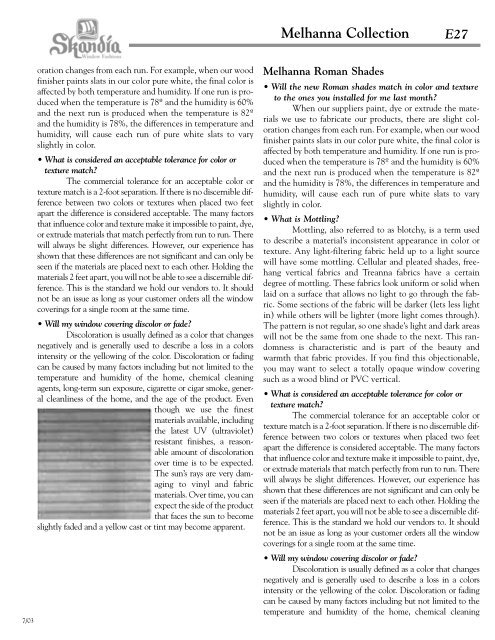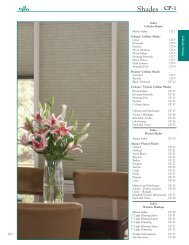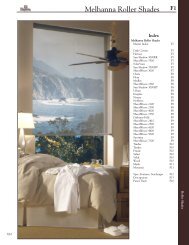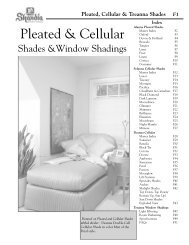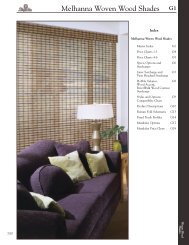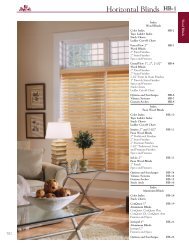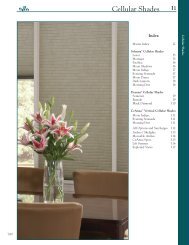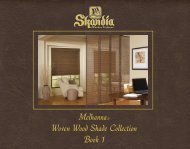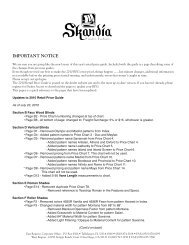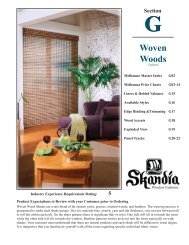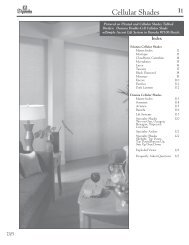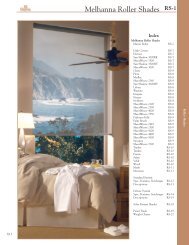Melhanna Collection - Skandia Window Fashions
Melhanna Collection - Skandia Window Fashions
Melhanna Collection - Skandia Window Fashions
Create successful ePaper yourself
Turn your PDF publications into a flip-book with our unique Google optimized e-Paper software.
<strong>Melhanna</strong> <strong>Collection</strong>E277/03oration changes from each run. For example, when our woodfinisher paints slats in our color pure white, the final color isaffected by both temperature and humidity. If one run is producedwhen the temperature is 78º and the humidity is 60%and the next run is produced when the temperature is 82ºand the humidity is 78%, the differences in temperature andhumidity, will cause each run of pure white slats to varyslightly in color.• What is considered an acceptable tolerance for color ortexture match?The commercial tolerance for an acceptable color ortexture match is a 2-foot separation. If there is no discernible differencebetween two colors or textures when placed two feetapart the difference is considered acceptable. The many factorsthat influence color and texture make it impossible to paint, dye,or extrude materials that match perfectly from run to run. Therewill always be slight differences. However, our experience hasshown that these differences are not significant and can only beseen if the materials are placed next to each other. Holding thematerials 2 feet apart, you will not be able to see a discernible difference.This is the standard we hold our vendors to. It shouldnot be an issue as long as your customer orders all the windowcoverings for a single room at the same time.• Will my window covering discolor or fade?Discoloration is usually defined as a color that changesnegatively and is generally used to describe a loss in a colorsintensity or the yellowing of the color. Discoloration or fadingcan be caused by many factors including but not limited to thetemperature and humidity of the home, chemical cleaningagents, long-term sun exposure, cigarette or cigar smoke, generalcleanliness of the home, and the age of the product. Eventhough we use the finestmaterials available, includingthe latest UV (ultraviolet)resistant finishes, a reasonableamount of discolorationover time is to be expected.The sun’s rays are very damagingto vinyl and fabricmaterials. Over time, you canexpect the side of the productthat faces the sun to becomeslightly faded and a yellow cast or tint may become apparent.<strong>Melhanna</strong> Roman Shades• Will the new Roman shades match in color and textureto the ones you installed for me last month?When our suppliers paint, dye or extrude the materialswe use to fabricate our products, there are slight colorationchanges from each run. For example, when our woodfinisher paints slats in our color pure white, the final color isaffected by both temperature and humidity. If one run is producedwhen the temperature is 78º and the humidity is 60%and the next run is produced when the temperature is 82ºand the humidity is 78%, the differences in temperature andhumidity, will cause each run of pure white slats to varyslightly in color.• What is Mottling?Mottling, also referred to as blotchy, is a term usedto describe a material’s inconsistent appearance in color ortexture. Any light-filtering fabric held up to a light sourcewill have some mottling. Cellular and pleated shades, freehangvertical fabrics and Treanna fabrics have a certaindegree of mottling. These fabrics look uniform or solid whenlaid on a surface that allows no light to go through the fabric.Some sections of the fabric will be darker (lets less lightin) while others will be lighter (more light comes through).The pattern is not regular, so one shade’s light and dark areaswill not be the same from one shade to the next. This randomnessis characteristic and is part of the beauty andwarmth that fabric provides. If you find this objectionable,you may want to select a totally opaque window coveringsuch as a wood blind or PVC vertical.• What is considered an acceptable tolerance for color ortexture match?The commercial tolerance for an acceptable color ortexture match is a 2-foot separation. If there is no discernible differencebetween two colors or textures when placed two feetapart the difference is considered acceptable. The many factorsthat influence color and texture make it impossible to paint, dye,or extrude materials that match perfectly from run to run. Therewill always be slight differences. However, our experience hasshown that these differences are not significant and can only beseen if the materials are placed next to each other. Holding thematerials 2 feet apart, you will not be able to see a discernible difference.This is the standard we hold our vendors to. It shouldnot be an issue as long as your customer orders all the windowcoverings for a single room at the same time.• Will my window covering discolor or fade?Discoloration is usually defined as a color that changesnegatively and is generally used to describe a loss in a colorsintensity or the yellowing of the color. Discoloration or fadingcan be caused by many factors including but not limited to thetemperature and humidity of the home, chemical cleaning


